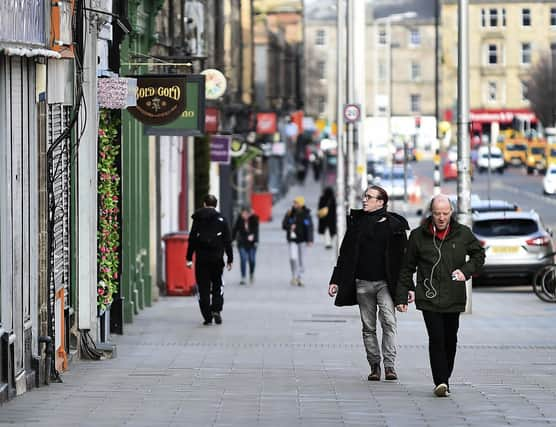Edinburgh and Glasgow roads with most crashes per mile revealed


Leith Walk has the highest number of injury crashes per mile of any road in Scotland, according to new analysis.
The busy street is among six in Edinburgh featuring in a top ten compiled by the data unit of JPI Media, which owns The Scotsman and Edinburgh Evening News.
Advertisement
Hide AdAdvertisement
Hide AdIt showed there were 84.5 crashes per mile on between Leith Walk and Leith Street – part of the A900 – between 2014 and 2018.
That was approaching twice as many as on the second-placed road, the A7, that includes North and South Bridges, and Dalkeith Road, which had 48.9.
The A77 and M77 on the south side of Glasgow was placed third, with 41.1 incidents per mile.
Fourth was the A761 between Glasgow and Port Glasgow, which includes Paisley Road West in the city, at 39.8.
Advertisement
Hide AdAdvertisement
Hide AdThe other Edinburgh roads in the top ten were the A1140 Portobello Road (35.8 incidents), the A8 – main route into city centre from west (34.7), the A1 (33) and the A700 Tollcross-Melville Drive (32.1).
The other roads in the top ten were the A81 in the north of Glasgow, which includes Maryhill Road, and the A879 in East Dunbartonshire, north of Glasgow.
The figures, based on UK Department for Transport data, do not take account of traffic volumes, so are not ranked according to risk of a collision.
Road safety charity Brake said there were steps drivers could take to prevent crashes, such as slowing down, not using mobile phones behind the wheel and getting their eyesight tested regularly.
Advertisement
Hide AdAdvertisement
Hide AdBut it also said there needed to be “greater investment in road traffic enforcement so that people who do drive dangerously and break the law, endangering themselves and all other road users, are caught and punished”.
Neil Greig, the Scotland-based policy and research director of the IAM RoadSmart motoring group, said: “It’s a bit of a surprise to see Leith Walk topping this table as in the past Scotland’s most dangerous roads have tended to be rural routes.
“In reality, however, its mix of heavy traffic, large numbers of pedestrians and cyclists and multiple straight lanes is an obvious hazard.
“Simply putting up a few 20mph signs has clearly not worked, although that may not be fully reflected in these figures.
Advertisement
Hide AdAdvertisement
Hide Ad“Major change is coming to the A900 with the tram extension, but this report would suggest some spending is needed now to shift it down a league table nobody wants to be top of.”
Philip Gomm, of the RAC Foundation, said: “Whilst headline numbers for crashes and casualties are important, context is key. We need to know how the figures relate to things like traffic volume.
“Even in these difficult times Scottish ministers must ensure hard won progress in improving safety doesn’t go into reverse and spending on keeping roads up to the highest standards is maintained.”
Edinburgh City Council transport convener Lesley Macinnes said: “While we take any accidents extremely seriously, these figures do not reflect factors such as traffic, pedestrian and cycling levels or the severity of collisions. Data like this can often be used to produce misleading claims.
Advertisement
Hide AdAdvertisement
Hide Ad“Our own road safety team undertakes rigorous regular collision investigations using data provided by Police Scotland into all streets to determine locations where the collision rate is giving cause for concern and where remedial works may require to be implemented.”
A spokesman for Glasgow City Council said: “We have a number of concerns with the way these statistics have been assembled and there are other data sets available that provide a more useful understanding of risk on certain roads.
“What these statistics miss is the sustained reduction in road incidents and casualties that has taken place in Glasgow over the past ten years.
“A range of engineering, education, encouragement and enforcement measures have all contributed to safer roads within the city.
Advertisement
Hide AdAdvertisement
Hide Ad“We are also implementing new policies such as school car free zones and a city wide 20mph speed limit, which will help to improve road safety further, and updating our plans in line with Scottish Government targets.”
A message from the Editor:
Thank you for reading this story on our website.
While I have your attention, I also have an important request to make of you.
With the coronavirus lockdown having a major impact on many of our advertisers - and consequently the revenue we receive - we are more reliant than ever on you taking out a digital subscription.
Subscribe to scotsman.com and enjoy unlimited access to Scottish news and information online and on our app.
Advertisement
Hide AdAdvertisement
Hide AdWith a digital subscription, you can read more than 5 articles, see fewer ads, enjoy faster load times, and get access to exclusive newsletters and content.
Visit https://www.scotsman.com/subscriptions now to sign up.
Our journalism costs money and we rely on advertising, print and digital revenues to help to support them.
By supporting us, we are able to support you in providing trusted, fact-checked content for this website.
Joy Yates
Editorial Director
Comment Guidelines
National World encourages reader discussion on our stories. User feedback, insights and back-and-forth exchanges add a rich layer of context to reporting. Please review our Community Guidelines before commenting.